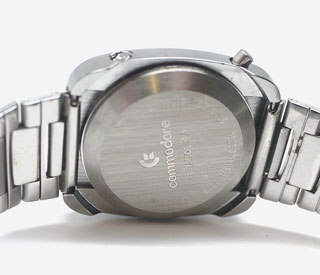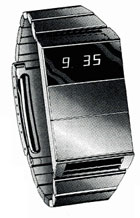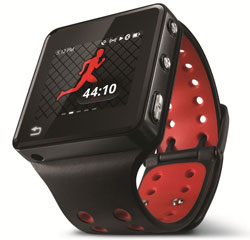Before PCs, There Were Digital Watches
How a short-lived fad of the 1970s foreshadowed the computing revolution to come.By Harry McCracken | Wednesday, January 4, 2012 at 3:34 am

This is my new watch. If you ever owned a Commodore 64 or an Amiga, you recognize that insignia below the display: It belongs to Commodore, the company that sold vast quantities of personal computers in the 1980s before petering out in the early 1990s.
My new watch is also an old watch: It’s a Commodore Time Master, manufactured in 1976 or thereabouts. I bought it from a specialist called LED Watch Stop, which has a supply of new-old-stock Time Masters that never got sold back in the 1970s. (It’s selling them for $229 apiece at the moment, although the price was $129 just a few days ago–I guess I lucked into a sale when I impulsively ordered one.)
 The Time Master is an LED watch, using battery-hogging display technology that forces you to press a button on the right side to see the time. (I faked the LED readout in the photo above.) It’s especially unwieldy for southpaws such as me, since it’s hard to reach the button without covering the screen with your palm. And to save money, it uses a dinky LED with a magnifier, resulting in a display that’s impossible to read unless you look at it straight on.
The Time Master is an LED watch, using battery-hogging display technology that forces you to press a button on the right side to see the time. (I faked the LED readout in the photo above.) It’s especially unwieldy for southpaws such as me, since it’s hard to reach the button without covering the screen with your palm. And to save money, it uses a dinky LED with a magnifier, resulting in a display that’s impossible to read unless you look at it straight on.
On the plus side, the watch seems to keep good time, and it’s a heck of a geek conversation piece. (Until now, I sort of assumed that my Amiga 500, which I got in 1987, would be the last Commodore product I’d ever own and use.)

A Hamilton digital-watch prototype, as seen in Popular Science in 1970.
When Commodore starred making watches in 1975, it was a calculator company, not a computer maker: Its first PCs, the Kim-1 and PET 2001, didn’t come along until 1976 and 1977, respectively. And it did indeed make watches rather than slapping its name on no-name ones imported from Asia–its early models, in fact, were assembled in Palo Alto, California, in the heart of Silicon Valley. Mine’s a later version assembled in France; still later variants used technologies from Micro Display Systems and Frontier Semiconductor, startups acquired by Commodore.
The company entered the watch field when digital watches were still a newfangled wonder, having debuted when Hamilton released its first Pulsar in 1972. That model sold for $2100, which was more than a new Ford Pinto went for at the time. By the time Commodore released its first models three years later, digitals had become mass-market items. The company was part of a great price plunge, much as it would be in the 1980s as the Commodore 64 went from its starting price of $595 to selling for under a hundred bucks.

Patent drawing for HP's HP-01 calculator watch.
And some of the companies which Commodore competed with during the digital watch craze would be the same ones which would be major players once the PC revolution got underway a few years later.
Intel, for instance, had bought watchmaker Microma in 1972, when digital models were still high-ticket items and the market for its microprocessors barely existed; Micromas were some of the first consumer products with Intel Inside. (They also had LCD displays that didn’t make you press a button to see the time.) At the high end, Hewlett-Packard introduced the HP-01, an amazing $650 calculator watch with 28 minuscule buttons you had to press with a tiny stylus. On the low end, Texas Instruments helped to knock the price of digital watches down to $10 by flooding the market with plasticky models.

Sinclair's Black Watch.
Then there was 1975’s Black Watch, from British gizmo-designing legend Clive Sinclair. A $29.95 DIY kit, it even looked a tad like a dinky version of his slablike ZX-80 computer, introduced five years later.
In short, the 1970s watch business was a preview of the 1980s PC business. For the first time, a bunch of electronics companies which had previously specialized in scientific equipment and business machines started learning about selling gadgets to consumers. In fact, digital watch manufacturers marketed their products as computing devices. Hamilton claimed the first Pulsar was a “Time Computer.” thinking it a sexier category than “wristwatch.” HP called its 01 a “personal information instrument,” as if it were trying to invent the PDA a decade and a half before PDAs actually came to be.
Still, by the time the 01 came out in 1977 there were signs that the digital-watch business was destined to become a dreary commodity industry. Commodore LED watches not too different from my Time Master, for instance, were being offered as a $7.99 premium to people who sent in box tops from Hunt’s Snack Pack canned pudding, which is probably not what Commodore had in mind when it became a watchmaker.

All of the soon-to-be-PC-companies’ forays into the watch business had unhappy endings. Discouraged by the HP-01’s sales, HP killed a successor called the HP-02. (Today, the 01 goes for big bucks on eBay.) The Black Watch had so many problems–it ran at different speeds in different temperatures and the batteries sometimes exploded–that it nearly drove Sinclair into bankruptcy.

Microma watches with Intel 5830 microcircuits, as seen in Intel's 1975 annual report.
In 1978, Intel sold its watch designs to Timex and the Microma name to a Swiss company. It had taken such a beating on the whole effort that cofounder Gordon Moore continued to wear a Microma watch for years to remind himself not to do anything so foolish again Texas Instruments held on a bit longer, but called it quits in 1981.
And Commodore? Well, I’m not sure when it sold its last timepiece. But in Commodore: A Company on the Edge, Brian Bagnall says that the company brought watches to the 1981 Consumer Electronics Show but didn’t have much luck with them. “The Commodore name,” he explains, “was not one people associated with watches.”

Motorola's TI-powered Motoactv sports watch.
The timing of all this failure turned out to be fortuitous. It let the companies in question refocus their energies on the emerging PC market. While that too turned out to be a cutthroat business, it had staying power. TI didn’t fare too well, but Commodore did for a time, and Intel and HP are still at it in 2012. Even if watches had sold better, they would have been a distraction.
Then again, in the technology industry it’s always a mistake to declare any product category to be permanently dead. Thanks to products such as WIMM and Motorola’s Motoactv, which pack smartphone-like power and run sophisticated apps, digital watches are intriguing again in a way they haven’t been in decades. The Motoactv even uses a Texas Instruments OMAP chip, making it a very, very distant descendant of the watches that TI sold in the 1970s. And the notion of Intel and HP getting back into watches, in one way or another, isn’t the least bit kooky.
There’s even a modern-day Commodore selling a Intel-based Commodore 64. It would have every right to start hawking watches, I suppose. But unless its timepieces, like my Time Master, are custom-designed products based on the company’s own technologies and components, I won’t be tempted. We Commodore watch owners, you see, tend to be kind of snobbish.
Comments are closed
Read more:













January 4th, 2012 at 10:07 am
Dick Tracy was so far ahead of his time. I wonder whatever happened to mine. It proved useful on a couple of "I'd give you my number but I don't have a pen occasions!"
January 4th, 2012 at 12:08 pm
"There’s even a modern-day Commodore selling a Intel-based Commodore 64. It would have every right to start hawking watches, I suppose. But unless its timepieces, like my Time Master, are custom-designed products based on the company’s own technologies and components, I won’t be tempted. We Commodore watch owners, you see, tend to be kind of snobbish."
So do we C64 owners 😉
If it aint real who cares 🙂
January 4th, 2012 at 9:42 pm
For anyone unaware: the systems being sold by Commodore are average modern computers loaded with Linux inside a shell designed to mimic a C64.
January 5th, 2012 at 5:59 am
I remember the digital watch craze well. I was 10 years old when I got one for my birthday in the late 70s. I drove my parents crazy wearing out batteries in that thing. They would only stay running for a few weeks at most with a ten year old kid pushing the button every 28 seconds! The batteries were relatively expensive, and sooner or later I got an LCD watch.
January 5th, 2012 at 7:04 am
I was in basic training in the US Army when these things were displayed at the PX. As soon as most recruits got paid, the watches were on arms everywhere. Since the bright red LED showed very prominently at night, they were sold with special watchbands with velcro covers to keep them out of sight for night manuevers. Being married and sending most of my pay home, I couldn't believe how much soldiers were willing to pay for what was really the new 'bling' of the 70's.
January 5th, 2012 at 7:30 am
The watches I remember were the Casio Databank LCD watches. They were practically PDAs other than the fact that you had limited screen space and had to use those tiny keyboards.
January 5th, 2012 at 7:34 am
Of all the '70s watches displayed, I have to say the Black watch looks the most stylish, wouldn't you say?
Check out the Casio F-91W, still in production since the '70s and is now as cheap as chips. My mates saved up and bought them when I wasa student, and I bought my first one last year (!), and it keeps astonishingly consistent time (it still tracks the BBC time-pips nearly a year since I first set the time!)
January 5th, 2012 at 11:38 am
Even Hughes Aircraft Company, where I worked, had a digital watch for a short while. I wish I still had, one even though It did not come equiped with some of their other technologies such as maverick and TOW missiles, phase array radars. communication satellites, DirecTV and lasers.
January 6th, 2012 at 5:57 am
Phil I still have mine in the oiginal case. My mom worked there and she gave one to me as a birthday present. I think it still works if I could find a battery that would fit. I think the watch was actually made by Benrus using Hughes Aircraft electronic components.
Ross
January 6th, 2012 at 4:12 am
The Casio watches are excellent piece of time machine. Innovation and customized at it best. The casio watch are always ahead of technology.